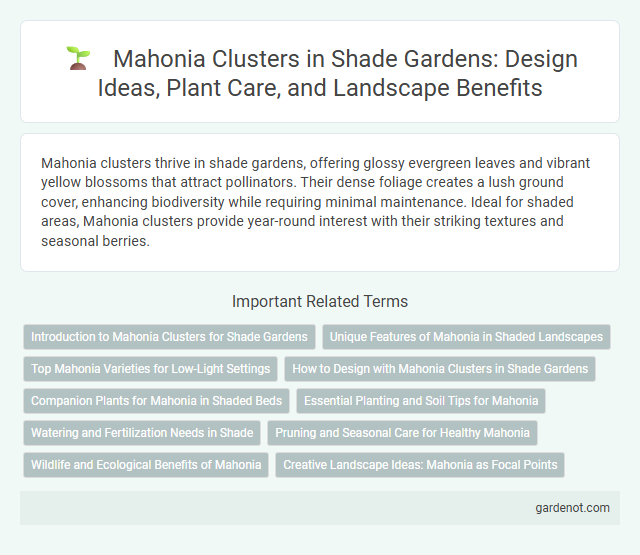Mahonia clusters thrive in shade gardens, offering glossy evergreen leaves and vibrant yellow blossoms that attract pollinators. Their dense foliage creates a lush ground cover, enhancing biodiversity while requiring minimal maintenance. Ideal for shaded areas, Mahonia clusters provide year-round interest with their striking textures and seasonal berries.
Introduction to Mahonia Clusters for Shade Gardens
Mahonia clusters are ideal for shade gardens due to their tolerance of low light conditions and evergreen foliage. These shrubs produce vibrant yellow flowers in late winter to early spring, enhancing garden interest during dormant seasons. Their adaptability to moist, well-drained soil makes Mahonia clusters a resilient and attractive choice for shaded landscape areas.
Unique Features of Mahonia in Shaded Landscapes
Mahonia clusters thrive in shaded garden landscapes due to their evergreen foliage and vibrant yellow flowers that bloom in late winter, adding color when few other plants do. Their leathery, holly-like leaves are resistant to deer and drought, making them a low-maintenance choice for woodland gardens. The plant's ability to tolerate deep shade and acidic soils enhances biodiversity by providing shelter and food for pollinators like bees and birds.
Top Mahonia Varieties for Low-Light Settings
Mahonia cluster thrives in low-light conditions, making it an ideal choice for shade gardens where sunlight is limited. Popular Mahonia varieties for these settings include Mahonia aquifolium 'Apollo', known for its compact form and vibrant blue berries, and Mahonia eurybracteata 'Soft Caress', prized for its soft, fern-like foliage. These varieties not only tolerate shade but also add year-round visual interest with their evergreen leaves and early yellow blooms.
How to Design with Mahonia Clusters in Shade Gardens
Mahonia clusters thrive in shade gardens by providing dense, evergreen foliage with vibrant yellow blooms that brighten low-light areas. Position multiple Mahonia plants close together to create textured layers and enhance visual interest through their spiky leaves and contrasting flowers. Incorporate Mahonia clusters alongside ferns and hostas for a balanced, naturalistic woodland planting that supports year-round color and structure.
Companion Plants for Mahonia in Shaded Beds
Mahonia clusters thrive in shaded garden beds and benefit from companion plants like ferns, hostas, and hellebores that complement their evergreen foliage and yellow blooms. These companions add texture and color contrast, creating a visually appealing understory while maintaining similar moisture and soil requirements. Integrating woodland plants such as astilbes and lungwort enhances biodiversity and supports a balanced ecosystem within shade gardens featuring Mahonia.
Essential Planting and Soil Tips for Mahonia
Mahonia clusters thrive in well-drained, organically rich soil with a slightly acidic to neutral pH, ensuring robust growth and vibrant foliage. Plant mahonia in shaded to partially shaded areas to mimic its natural woodland habitat, promoting healthy, dense clusters. Regular mulching retains soil moisture and regulates temperature, crucial for preventing root stress in shade garden environments.
Watering and Fertilization Needs in Shade
Mahonia cluster thrives in shaded environments with moderate watering to keep the soil consistently moist but not waterlogged. Regular fertilization using a balanced, slow-release fertilizer in early spring supports healthy foliage and vibrant yellow blooms. This low-maintenance plant benefits from mulching to retain soil moisture and regulate temperature in shade gardens.
Pruning and Seasonal Care for Healthy Mahonia
Regular pruning of Mahonia clusters in shade gardens helps maintain their dense, attractive foliage and encourages new growth. Seasonal care involves trimming back old stems in late winter or early spring before new leaves emerge, promoting vibrant blooms and preventing disease. Applying mulch around the base during colder months protects roots from frost and conserves moisture, supporting overall plant health.
Wildlife and Ecological Benefits of Mahonia
Mahonia clusters provide essential habitat and food sources for birds, bees, and butterflies, promoting biodiversity in shaded garden environments. Their evergreen leaves offer shelter and nesting sites, while bright yellow flowers support early spring pollinators. Mahonia also contributes to soil health by preventing erosion and enhancing microbial activity through its dense root system.
Creative Landscape Ideas: Mahonia as Focal Points
Mahonia clusters create striking focal points in shade gardens with their bold evergreen foliage and vibrant yellow blooms that brighten dim corners. Their spiky leaves add texture and contrast, enhancing garden depth and visual interest throughout the year. Incorporating Mahonia as centerpiece plants complements surrounding shade-tolerant species like hostas and ferns for a dynamic, layered landscape design.
Mahonia cluster Infographic

 gardenot.com
gardenot.com